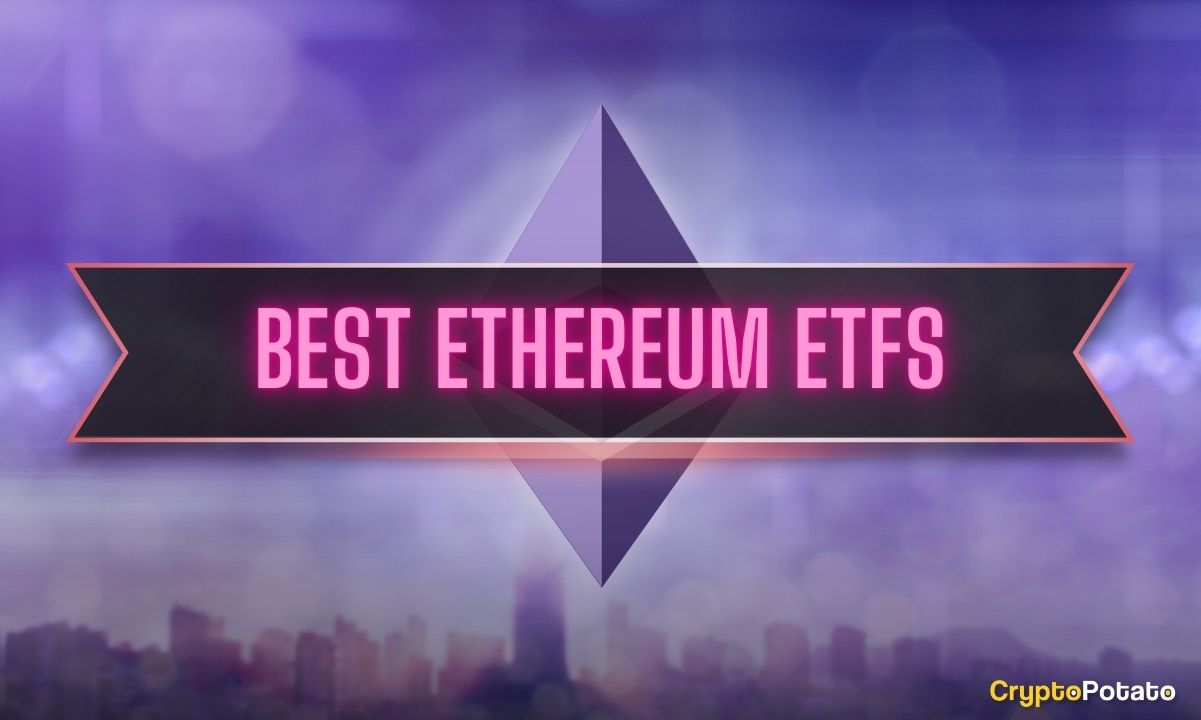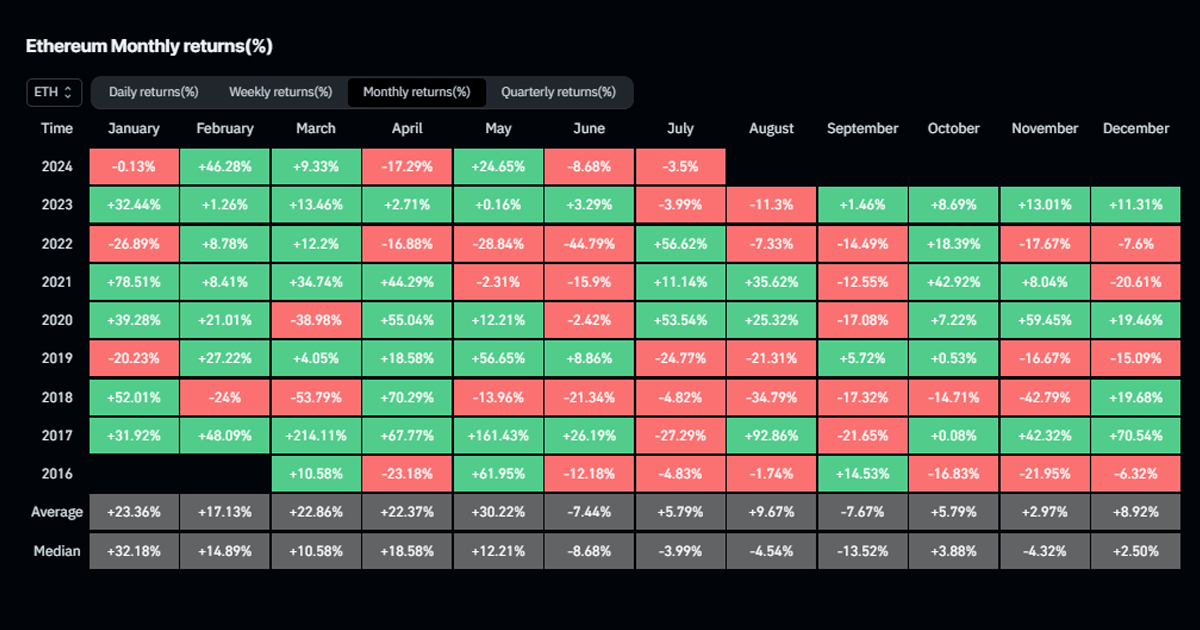Ethereum
9 Best Ethereum (ETH) ETFs in 2024: Full Comparison, Fees, Alternatives

The Securities and Exchange Commission (SEC) finally approved spot ether ETFs, which started trading on July 23rd, 2024. This was a significant milestone for the cryptocurrency industry that builds upon the earlier success of spot bitcoin ETFs. The move has spurred increased interest and optimism in the market, reflecting the broader acceptance and integration of digital assets within the financial system.
However, Ethereum ETFs have also been a subject of debate regarding the long-term impact they might have on the Ethereum ecosystem —especially since ETFs were obliged to exclude staking, a fundamental part of the Ethereum blockchain.
This guide will detail all you need to know about spot Ethereum ETFs, including how they work, the challenges ETFs (and the Ethereum network) could face in the future, the complex regulatory landscape in the US, and, of course, a detailed list of all nine ETFs approved in July 2024.
Quick Navigation
What is a Spot Ethereum ETF?
A spot Ethereum exchange-traded fund (ETF) is a financial product that tracks the price of Ethereum (ETH), enabling investors to buy and sell shares on traditional stock exchanges. This provides a regulated and straightforward way to gain exposure to ETH’s performance without the hassle of managing digital assets directly.
By operating within traditional financial markets, these ETFs offer a secure and compliant investment pathway, enhancing investor confidence and adhering to established financial regulations.
Given Ethereum’s complex ecosystem, one of the main challenges that slowed down the approval of spot Ethereum ETFs was establishing agreed-upon buying and selling procedures. That is, choosing between in-kind and in-cash redemption models.
In-Kind/In-Cash Redemption for Spot Ethereum ETFs
Like spot Bitcoin ETFs, the SEC requested issuers that all spot Ethereum ETFs use an in-cash redemption model instead of in-kind, aligning with the agency’s preference for enhanced regulatory oversight and market integrity in crypto-based investment vehicles.
While we covered how in-kind vs. in-cash models work in our guide on the Best Bitcoin ETFs in 2024: Fees, Alternatives, and How to Buy, let’s do a quick recap on how these models work.
In-Kind Redemption Model
The in-kind redemption model helps ETFs maintain tax efficiency by avoiding the sale of appreciated securities to meet redemptions. Two crucial points for this particular model include:
Authorized participants (APs) exchange ETF shares for a basket of underlying securities held by the ETF rather than for cash. Only APs —typically institutional investors— can redeem the shares directly for a proportional basket of the underlying securities/assets.
In-kind redemptions do not trigger a taxable event for the ETF in question because no securities are sold to generate cash, and capital gains taxes are deferred for non-redeeming shareholders, making this model more tax-efficient than mutual funds. Institutions benefit from reduced trading and transaction costs.
In-Cash Redemption Model
The in-cash redemption model involves the APs receiving cash instead of a basket of securities when redeeming ETF shares. This model is relatively standard for ETFs holding less liquid assets or actively managed ETFs that prefer to keep their strategies confidential. In a nutshell:
APs deposit cash into the ETF, which is then used to purchase the underlying assets— or the ETF sells the underlying assets to generate the needed cash. In short, the APs exchange ETF shares for cash equivalent to the redeemed shares’ net asset value (NAV).
In-cash simplifies the redemption process by dealing in cash rather than securities, but they are less tax-efficient because selling securities to generate cash can trigger taxable events, leading to capital gains distributions that affect all shareholders. When selling the underlying assets, higher transaction costs are incurred due to bid/ask spreads and broker commissions.
Similarly to spot Bitcoin ETFs, the SEC mandated that redemptions must be in cash rather than in-kind for all the nine approved Ethereum ETFs.
Here’s a table showcasing the above:
How Different are Ethereum ETFs to Bitcoin ETFs?
While they work similarly using cash for in-kind redemptions, the nature of both cryptocurrencies differs mainly due to each coin’s consensus algorithm.
Ethereum Staking, the SEC’s Biggest Problem
After Ethereum ditched the Proof-of-Work (PoW) model in 2022 and adopted the Proof-of-Stake (PoS) model instead, many questions arose regarding its viability as a traditional investment vehicle for institutional investors.
Like miners are crucial for the Bitcoin network, staking is crucial for Ethereum’s consensus mechanism (it wouldn’t be called proof of stake otherwise). Staking allows holders to lock up their ETH to validate transactions and secure the network in exchange for rewards.
Staking has become one of the most popular yield-accruing mechanisms in the crypto market because it can significantly enhance crypto holders’ return on investment (ROI). Staking rewards typically range from 1% to 4% annually, while some pools can generate over 10% in APR. This is akin to interest on a savings account—but on steroids.
However, the SEC is not quite fond of this idea and has expressed that staking is similar to an investment contract.
The SEC’s Stance on Staking in ETFs
The SEC has mandated that spot Ethereum ETFs exclude staking features to gain regulatory approval. The agency’s decision is based on its concern that staking could be considered an offering of unregistered securities.
The Commission’s interpretation is grounded in the Howey Test, which assesses whether an asset qualifies as an investment contract. According to the agency’s logic, staking involves investing money with an expectation of profits derived from the efforts of others, potentially classifying it as a security.
So, to align with the SEC’s regulatory expectations and avoid legal challenges, issuers of spot Ethereum ETFs, such as BlackRock, Grayscale, and Bitwise, amended their ETF filings to exclude staking provisions. This strategic adjustment was necessary to secure SEC approval.
This leads to certain consequences:
Without staking, spot Ethereum ETFs may be less attractive to investors compared to direct ETH holdings, which allow for staking and the associated rewards. This could lead to a lower overall return on investment for ETF holders.
Excluding staking ensures that the ETFs comply with SEC regulations, avoids potential legal issues, and facilitates smoother approval processes.
It’s probably the most important factor here.
The absence of staking in Ethereum ETFs can affect Ethereum’s ecosystem and the market dynamics of ETH, including the total amount of ETH staked and the overall network security and decentralization. This refers to the fact that no one associated with the Ethereum ETFs, not even custodians, can perform ETH staking. You can find this information on Franklin Templeton’s S-1 filing:
Therefore, what happens to all of the ETH held by custodians? This is a question that Swissblock asked in its blog post called ETH ETFs, a “decaf” version of Ethereum, stating that without staking, investors are missing a fundamental part of what makes Ethereum unique:
“[Ether] powers the machinery of Web3 and is likely to make applications possible that will drive decentralized value in everyone’s life in ways we cannot even grasp yet. An ETF is just a speculative shadow you can use to bet on that future while missing out on real ownership and staking rewards for the sake of comfort.”
While the current regulatory environment requires the exclusion of staking from Ethereum ETFs, there is ongoing debate and potential for future changes. Market observers and analysts hope that as regulatory frameworks evolve, staking might eventually be included in these financial products, enhancing their attractiveness and aligning more closely with Ethereum’s unique features. That remains to be seen.
Best Ethereum Spot ETFs
Now that we have all the essential information, let’s review the best Ethereum ETFs.
Keep in mind that the funds’ facts and key information are subject to change, and certain information is not publicly available or differs per fund. For example, certain funds prefer to display Net Asset Value (BlackRock), while others, like Grayscale, use Asset Under Management (AUM).
BlackRock’s iShares Ethereum Trust (ETHA)
The BlackRock iShares Ethereum Trust (ETHA) is the largest Ethereum ETF managed by the largest asset manager in history, BlackRock.
Like the other ETFs, ETHA is designed to provide investors with exposure to the spot price of ETH. This allows traditional investors to benefit from ETH’s price movements without having to buy or directly own the cryptocurrency.
Shares of ETHA are traded on Nasdad with a fee of 0.12% until the waiver period ends or the fund reaches $2.5B, at which point the fee will be incremented to 0.25%.
Fund Facts
Overview and fund facts:
- Fund inception: July 23, 2024
- Fee (with waiver): 0.25% (0.12%)
- Waiver period/limits: 12 months or $2.5 billion
- Exchange: Nasdaq
- Type: New
- Custodian: Coinbase
Grayscale Ethereum Trust (ETHE)
Grayscale Ethereum Trust (ETHE) is the second-largest Ethereum ETF by volume and is managed by Grayscale Investments.
The product provides investors with exposure to ETH without purchasing the asset directly, simplifying the process of investing in the Ethereum ecosystem. It was first launched as a private placement in 2017 and began trading publicly on OTC Markets in mid-2019. Grayscale converted the trust into an ETF and updated it to NYSE Arca in 2024.
ETHE charges an annual management fee of 2.5%, which is considerably high, but the fee covers the costs associated with the administration and safekeeping of its ETH balance.
Fund Facts
Overview and fund facts:
- Fund inception: December 14, 2017
- Fee (with waiver): 2.50%
- Waiver period: None
- Exchange: NYSE Arca
- Custodian: Coinbase
- Type: Conversion
Grayscale Ethereum Mini Trust (ETH)
The Grayscale Ethereum Mini Trust (ETH) is a new financial product launched by Grayscale Investments, offering significantly lower fees than Grayscale’s ETHE.
The fund began trading on NYSE Arca on July 23, 2024. Like the other ETFs. It is designed to provide investors with exposure to ETH (the coin, not the fund). However, note that ETH is not a fund registered under the Investment Company Act of 1940. This means it is not subject to regulation under this act, unlike most mutual funds or ETFs.
Overall, the difference between ETH and ETHE is that ETH charges zero fees until it reaches $2B (or after six months of trading); then the fees will be incremented to 0.15%, which is relatively standard for ETFs.
Fund Facts
Overview and fund facts:
- Fund inception: July 18, 2024
- Fee (with waiver): 0.15% (0.00%)
- Waiver period/limits: 6 months or up to $2B
- Exchange: NYSE Arca
- Type: New
- Custodian: Coinbase
Franklin Ethereum ETF (EZET)
The Franklin Ethereum ETF (EZET) is a top Ethereum ETF that allows traditional investors to gain exposure to the spot price of ETH.
Like Grayscale’s Mini Trust, The ETF was launched with an initial fee of 0.00%, effective until January 31, 2025, or until the fund accumulates $10 billion in assets. After this period, the expense ratio will rise to 0.19%.
Fund Facts
Overview and fund facts:
- Fund inception: July 23, 2024
- Fee (with waiver): 0.19% (0.00%)
- Waiver period/limits: January 31, 2025, or $10B
- Exchange: Cboe BZX
- Type: New
- Custodian: Coinbase
VanEck Ethereum ETF (ETHV)
The VanEck Ethereum ETF (ETHV) provides investors with direct exposure to ETH, offering a straightforward way to gain exposure to the cryptocurrency’s performance.
ETHV is a part of VanEck’s offering of crypto-focused ETFs, which includes the VanEck Bitcoin Trust (HODL) and the VanEck Digital Transformation ETF (DAPP). As such, VanEck is recognized for pioneering direct digital asset exposure in the exchange-traded product market in the US. The fund will charge zero fees until it reaches 12 months (beginning from the first trading day) or reaches $1.5B.
Fund Facts
Overview and fund facts:
- Fund inception: June 25, 2024
- Fee (with waiver): 0.20% (0.00%)
- Waiver period/limits: 12 months or $1.5B
- Exchange: Cboe BZX
- Type: New
- Custodian: Gemini
Bitwise Ethereum ETF (ETHW)
The Bitwise Ethereum ETF (ETHW) trades on the New York Stock Exchange (NYSE) and provides a regulated and simple method for investors to gain exposure to ETH. The fund purchases ETH and stores the funds using the Bank of New York Mellon, one of the largest and most crypto-friendly banks in the US.
ETHW charges zero fees waived for the first six months or the initial $500 million in assets. Then, it will charge a management fee of 0.20%, which is also quite standard.
Note: Do not confuse Bitwise Ethereum Fund, a private fund for accredited investors, with Btiwise Ethereum ETF (ETHW), the actual spot exchange-traded fund for ETH.
Fund Facts
Overview and fund facts:
- Fund inception: July 22, 2024
- Fee (with waiver): 0.20% (0.00%)
- Waiver period/limits: 6 months or $500M
- Exchange: NYSE Arca
- Type: New
- Custodian: Bank of New York Mellon
21Shares Core Ethereum ETF (CETH)
The 21Shares Core Ethereum ETF (CETH) offers a streamlined and secure way to invest in Ethereum, eliminating the complexities of direct ownership. CETH buys ETH and holds the funds through Coinbase Custody.
CETH is part of the 21Shares crypto-focused ETF offering, including a Bitcoin ETF. 21Shares also has several exchange-traded products in the US and globally.
The fund started with a zero-fee approach similar to Grayscale’s Mini Trust, but the standard 0.21% fee will be applied after January 31, 2025, or for the first $500 million in assets.
Fund Facts
Overview and fund facts:
- Fund inception: July 22, 2024
- Fee (with waiver): 0.21% (0.00%)
- Waiver period/limits: 6 months or $500M
- Exchange: Cboe BZX
- Type: New
- Custodian: Coinbase
Invesco Galaxy Ethereum ETF (QETH)
The Invesco Galaxy Ethereum ETF (QETH) debuted on July 23, 2024, through a collaboration between Invesco Ltd. and Galaxy Asset Management, similar to what they did with their joint Bitcoin ETF.
The ETF invests directly in ETH and trades its shares on the Cboe BZX Exchange. Overall, QETH offers a straightforward and accessible way for a broad spectrum of investors to gain exposure to the spot price of ETH.
This is one of the funds with a flat fee of 0.25%; no waiver period/limits apply.
Fund Facts
Overview and fund facts:
- Fund inception: July 23, 2024.
- Fee (with waiver): 0.25%
- Waiver period/limits: None
- Exchange: Cboe BZX
- Type: New
- Custodian: Coinbase
Fidelity Ethereum Fund (FETH)
The Fidelity Ethereum Fund (FETH) provides fractional ownership of Ethereum through its fund structure, allowing investors to benefit from Ethereum’s price movements without directly handling the cryptocurrency. This ETF offers a regulated and convenient investment option for both individual and institutional investors.
The ETH is safeguarded by the company’s trusted custody arm, Fidelity Digital Assets, which has been regulated by the New York Department of Financial Services since 2019.
However, FETH is not registered under the Investment Company Act of 1940 nor regulated under the Commodity Exchange Act of 1936, meaning it lacks the investor protections typically associated with these regulations.
The fund charges no fees, waived until January 1, 2025. After this period, an expense ratio of 0.25% will be applied.
Fund Facts
Overview and fund facts:
- Fund inception: July 23, 2024
- Fee (with waiver): 0.25% (0.00%)
- Waiver period/limits: December 31, 2024
- Exchange: Cboe BZX
- Type: New
- Custodian: Fidelity Digital Assets
How to Invest in Spot Ethereum ETFs: What You Need to Know
First, you need to open a brokerage account and choose the ETFs you want to invest in. However, not all brokers offer ETF trading, and some might also have different deposit options.
Robinhood is one of the few brokers that offer ETF trading. Once your account is ready, deposit cash to start trading. The steps are pretty simple:
- Open an investment account.
- Fund the account with cash.
- Select the ETF you wish to purchase.
- Execute the trade to buy the ETF’s shares.
While the idea/objective is pretty straightforward (i.e., get ETH exposure), there are a few key points to consider:
Expense Ratio
Compare the management fees of different ETFs. Many issuers are currently offering fee waivers for initial periods.
Assets Under Management (AUM)
Larger funds may offer better liquidity and lower tracking errors.
Issuer Reputation
Consider the track record and reputation of the ETF provider.
Trading Volume
Higher trading volumes generally indicate better liquidity and tighter bid-ask spreads.
Another thing to consider is the lack of staking rewards. Staking directly on Ethereum is a more complex procedure that requires high-security hygiene practices and a certain level of knowledge of Ethereum and how it works.
Finally, check if you wish to buy and hold or actively trade the shares. For active traders, liquidity and tight bid-ask spreads are more important due to frequent trading in and out of positions. Higher liquidity allows for easier entry and exit and lower trading costs.
Long-term investors should prioritize low-cost ETFs to maximize returns, paying close attention to expense ratios and potential fee waivers. Active traders should focus on ETFs with high liquidity and tight bid-ask spreads to reduce trading costs.
Similar to Bitcoin ETFs, Fidelity also allows you to trade ETFs using a broker account, and you can open an account using IRAs, HSAs, or a simple brokerage account.
Alternatives to Spot Ethereum ETFs
If you’re looking for alternatives to spot Ethereum ETFs, several options provide exposure to Ethereum.
Here are some primary alternatives, each with unique characteristics and potential benefits.
Direct Cryptocurrency Investment
If you’re comfortable with the risks and complexities, you can just purchase Ethereum through a cryptocurrency exchange or perform a swap on a decentralized exchange by connecting your DeFi wallet. You can then stake ETH to generate yield.
Futures-Based Ethereum ETFs
Futures-based Ethereum ETFs are currently available in the U.S. They invest in Ethereum futures contracts rather than holding the cryptocurrency directly. Notable futures-based Ethereum ETFs include:
- ProShares Ether Strategy ETF (EETH): This ETF invests in Ethereum futures contracts, providing indirect exposure to Ethereum.
- VanEck Ethereum Strategy ETF (EFUT): Another option that focuses on Ethereum futures, offering a similar indirect investment approach.
- Bitwise Ethereum Strategy ETF (AETH): This ETF also invests in Ethereum futures and offers a reduced fee until October 2025, making it a potentially cost-effective choice.
Ethereum Exchange-Traded Notes (ETNs)
ETNs provide another way to gain exposure to Ethereum. Unlike ETFs, ETNs are debt instruments that track the performance of an underlying asset and are often physically backed by the cryptocurrency. Examples include:
- WisdomTree Physical Ethereum: This is an ETN physically backed by Ethereum, offering a direct link to the cryptocurrency’s performance.
- Global X Ethereum ETP: Another ETN backed by Ethereum that provides similar benefits.
- 21Shares Ethereum Staking ETP: This ETN offers exposure to Ethereum and the added benefit of staking rewards.
Blockchain ETFs
Blockchain ETFs invest in blockchain technology and cryptocurrency infrastructure companies, providing broader exposure to the sector rather than direct investment in cryptocurrencies. Examples include:
- Amplify Transformational Data Sharing ETF (BLOK): This ETF invests in companies heavily involved in blockchain technology, offering exposure to the infrastructure supporting cryptocurrencies.
- Siren Nasdaq NexGen Economy ETF (BLCN): This fund focuses on companies developing and utilizing blockchain technologies, providing a diversified approach to investing in the blockchain ecosystem.
Benefits of Spot Ethereum ETFs
The approval of spot Ethereum ETFs marks a significant milestone for both Ethereum and the broader cryptocurrency market. It offers investors a more traditional and regulated way to invest in Ethereum, potentially driving increased adoption, liquidity, and market stability.
It also places Ethereum as a legitimate asset within traditional finance. Therefore, the regulatory endorsement reassures investors that Ethereum ETFs are credible and regulated products, broadening ETH’s recognition and acceptance in mainstream financial markets.
Here are some of the benefits of spot Ethereum ETFs:
Increased Accessibility for Traditional Investors
Spot Ethereum ETFs provide a regulated and accessible way for traditional investors to gain exposure to the spot price of ETH without the complexities of directly owning and storing the cryptocurrency.
Potential for Increased Institutional Investment
Investors who may have been cautious about direct cryptocurrency investments now have a regulated and familiar vehicle to gain exposure to ETH’s spot price. This influx of institutional capital can lead to increased market liquidity and potentially greater price stability.
However, the main issue is dealing with Ethereum’s narrative, as most investors probably won’t invest in assets/financial products they do not understand. Hopefully, a change of narrative mixed with a change in the US regulatory landscape could lead to staking services being included in ETF offerings, potentially driving more demand for Ethereum ETFs.
Diversification for Cryptocurrency Portfolios
Both Bitcoin and Ethereum ETFs add another option for diversification within cryptocurrency-focused portfolios, allowing investors to easily balance their exposure between BTC and ETH through regulated ETF products.
Simplified Investment Process
Spot Ethereum ETFs simplify the investment process by eliminating the need for crypto wallets and exchanges. Investors can buy and sell Ethereum exposure through their existing brokerage accounts, making it as easy as trading stocks.
Regulatory Oversight and Investor Protection
These approved ETFs come with the benefit of regulatory oversight, potentially offering greater investor protection compared to direct cryptocurrency investments. This can help mitigate some of the risks associated with cryptocurrency exchanges and storage.
Closing Thoughts – The Best Ethereum ETFs in 2024
This article on the Best Ethereum ETFs provides a complete guide on everything you need to know about these groundbreaking crypto vehicles.
There are several ways to gain exposure to Ethereum and the broader cryptocurrency market. Each option offers unique benefits and risks, whether that is futures-based ETFs, ETNs, blockchain ETFs, or simply buying and holding ETH directly.
It’s important to consider all the challenges and risks that Ethereum ETFs face now that ETH is part of the open market. Hopefully, a change in the US regulatory framework could help Ethereum ETFs drive more demand by integrating staking, a fundamental part of the Ethereum network.
SPECIAL OFFER (Sponsored)
Binance Free $600 (CryptoPotato Exclusive): Use this link to register a new account and receive $600 exclusive welcome offer on Binance (full details).
LIMITED OFFER 2024 at BYDFi Exchange: Up to $2,888 welcome reward, use this link to register and open a 100 USDT-M position for free!
Ethereum
QCP sees Ethereum as a safe bet amid Bitcoin stagnation

QCP, a leading trading firm, has shared key observations on the cryptocurrency market. Bitcoin’s struggle to surpass the $70,000 mark has led QCP to predict Selling pressure is still strong, with BTC likely to remain in a tight trading range. In the meantime, Ethereum (ETH) is seen as a more promising investment, with potential gains as ETH could catch up to BTC, thanks to decreasing ETHE outflows.
Read on to find out how you can benefit from it.
Bitcoin’s Struggle: The $70,000 Barrier
For the sixth time in a row, BTC has failed to break above the $70,000 mark. Bitcoin is at $66,048 after a sharp decline. Many investors sold Bitcoin to capitalize on the rising values, which caused a dramatic drop. The market is becoming increasingly skeptical about Bitcoin’s rise, with some investors lowering their expectations.
Despite the continued sell-off from Mt. Gox and the US government, the ETF market remains bullish. There is a notable trend in favor of Ethereum (ETH) ETFs as major bulls have started investing in ETFs, indicating a bullish sentiment for ETH.
QCP Telegram Update UnderlinesIncreased market volatility. The NASDAQ has fallen 10% from its peak, led by a pullback in major technology stocks. Currency carry trades are being unwound and the VIX, a measure of market volatility, has jumped to 19.50.
The main factors driving this uncertainty are Value at Risk (VaR) shocks, high stock market valuations and global risk aversion sentiment. Commodities such as oil and copper have also declined on fears of an economic slowdown.
Additionally, QCP anticipates increased market volatility ahead of the upcoming FOMC meeting, highlighting the importance of the Federal Reserve’s statement and Jerome Powell’s subsequent press conference.
A glimmer of hope
QCP notes a positive development in the crypto space with an inflow of $33.7 million into ETH spot ETFs, which is giving a much-needed boost to ETH prices. However, they anticipate continued outflows of ETHE in the coming weeks. The recent Silk Road BTC moves by the US government have added to the market uncertainty.
QCP suggests a strategic trade involving BTC, which will likely remain in its current range, while ETH offers a more promising opportunity. They propose a trade targeting a $4,000-$4,500 range for ETH, which could generate a 5.5x return by August 30, 2024.
Ethereum
Ethereum Whale Resurfaces After 9 Years, Moves 1,111 ETH Worth $3.7 Million

An Ethereum ICO participant has emerged from nearly a decade of inactivity.
Lookonchain, a smart on-chain money tracking tool, revealed On X, this long-inactive participant recently transferred 1,111 ETH, worth approximately $3.7 million, to a new wallet. This significant move marks a notable on-chain movement, given the participant’s prolonged dormancy.
The Ethereum account in question, identified as 0xE727E67E…B02B5bFC6, received 2,000 ETH on the Genesis block over 9 years ago.

This initial allocation took place during the Ethereum ICOwhere the participant invested in ETH at around $0.31 per coin. The initial investment, worth around $620 at the time, has now grown to millions of dollars.
Recent Transactions and Movements
The inactive account became active again with several notable output transactions. Specifically, the account transferred 1,000 ETH, 100 ETH, 10 ETH, 1 ETH, and 1 more ETH to address 0x7C21775C…2E9dCaE28 within a few minutes. Additionally, it moved 1 ETH to 0x2aa31476…f5aaCE9B.
Additionally, in the latest round of transactions, the address transferred 737,995 ETH, 50 ETH, and 100 ETH, for a total of 887,995 ETH. These recent activities highlight a significant movement of funds, sparking interest and speculation in the crypto community.
Why are whales reactivating?
It is also evident that apart from 0xE727E67E…B02B5bFC6, other previously dormant Ethereum whales are waking up with significant transfers.
In May, another dormant Ethereum whale made headlines when it staked 4,032 ETHvalued at $7.4 million, after more than two years of inactivity. This whale initially acquired 60,000 ETH during the Genesis block of Ethereum’s mainnet in 2015.
At the time, this activity could have been related to Ethereum’s upgrade known as “Shanghai,” which improved the network’s scalability and performance. This whale likely intended to capitalize on the price surge that occurred after the upgrade.
Disclaimer: This content is informational and should not be considered financial advice. The opinions expressed in this article may include the personal opinions of the author and do not reflect the opinion of The Crypto Basic. Readers are encouraged to conduct thorough research before making any investment decisions. The Crypto Basic is not responsible for any financial losses.
-Advertisement-
Ethereum
Only Bitcoin and Ethereum are viable for ETFs in the near future

BlackRock: Only Bitcoin and Ethereum Are Viable for ETFs in the Near Future
Bitcoin and Ethereum will be the only cryptocurrencies traded via ETFs in the near future, according to Samara Cohen, chief investment officer of ETFs and indices at BlackRock, the world’s largest asset manager.
In an interview with Bloomberg TV, Cohen explained that while Bitcoin and Ethereum have met BlackRock’s rigorous criteria for exchange-traded funds (ETFs), no other digital asset currently comes close. “We’re really looking at the investability to see what meets the criteria, what meets the criteria that we want to achieve in an ETF,” Cohen said. “Both in terms of the investability and from what we’re hearing from our clients, Bitcoin and Ethereum definitely meet those criteria, but it’s going to be a while before we see anything else.”
Cohen noted that beyond the technical challenges of launching new ETFs, the demand for other crypto ETFs, particularly Solana, is not there yet. While Solana is being touted as the next potential ETF candidate, Cohen noted that the market appetite remains lacking.
BlackRock’s interest in Bitcoin and Ethereum ETFs comes after the successful launch of Ethereum ETFs last week, which saw weekly trading volume for the crypto fund soar to $14.8 billion, the highest level since May. The success has fueled speculation about the next possible ETF, with Solana frequently mentioned as a contender.
Solana, known as a faster and cheaper alternative to Ethereum, has been the subject of two separate ETF filings in the US by VanEck and 21Shares. However, the lack of CME Solana futures, unlike Bitcoin and Ethereum, is a significant hurdle for SEC approval of a Solana ETF.
Despite these challenges, some fund managers remain optimistic about Solana’s potential. Franklin Templeton recently described Solana as an “exciting and major development that we believe will drive the crypto space forward.” Solana currently accounts for about 3% of the overall cryptocurrency market value, with a market cap of $82 billion, according to data from CoinGecko.
Meanwhile, Bitcoin investors continue to show strong support, as evidenced by substantial inflows into BlackRock’s iShares Bitcoin Trust (NASDAQ: IBIT). On July 22, IBIT reported inflows of $526.7 million, the highest single-day total since March. This impressive haul stands in stark contrast to the collective inflow of just $6.9 million seen across the remaining 10 Bitcoin ETFs, according to data from Farside Investors. The surge in IBIT inflows coincides with Bitcoin’s significant $68,000 level, just 8% off its all-time high of $73,000.
Ethereum
Ethereum Posts First Consecutive Monthly Losses Since August 2023 on New ETFs

Available exclusively via
Bitcoin ETF vs Ethereum: A Detailed Comparison of IBIT and ETHA
Andjela Radmilac · 3 days ago
CryptoSlate’s latest market report takes an in-depth look at the technical and practical differences between IBIT and BlackRock’s ETHA to explain how these products work.
-

 Ethereum12 months ago
Ethereum12 months agoEthereum Posts First Consecutive Monthly Losses Since August 2023 on New ETFs
-

 Regulation12 months ago
Regulation12 months agoCryptocurrency Regulation in Slovenia 2024
-

 News12 months ago
News12 months agoNew bill pushes Department of Veterans Affairs to examine how blockchain can improve its work
-

 Regulation12 months ago
Regulation12 months agoThink You Own Your Crypto? New UK Law Would Ensure It – DL News
-

 Regulation12 months ago
Regulation12 months agoUpbit, Coinone, Bithumb Face New Fees Under South Korea’s Cryptocurrency Law
-

 Regulation12 months ago
Regulation12 months agoA Blank Slate for Cryptocurrencies: Kamala Harris’ Regulatory Opportunity
-

 Regulation12 months ago
Regulation12 months agoBahamas Passes Cryptocurrency Bill Designed to Prevent FTX, Terra Disasters
-

 Regulation12 months ago
Regulation12 months agoIndia to Follow G20 Policy for Cryptocurrency Regulation: MoS Finance
-

 News1 year ago
News1 year ago“Captain Tsubasa – RIVALS” launches on Oasys Blockchain
-

 Ethereum1 year ago
Ethereum1 year agoComment deux frères auraient dérobé 25 millions de dollars lors d’un braquage d’Ethereum de 12 secondes • The Register
-

 News12 months ago
News12 months agoEU supports 15 startups to fight online disinformation with blockchain
-

 News1 year ago
News1 year agoSolana ranks the fastest blockchain in the world, surpassing Ethereum, Polygon ⋆ ZyCrypto













